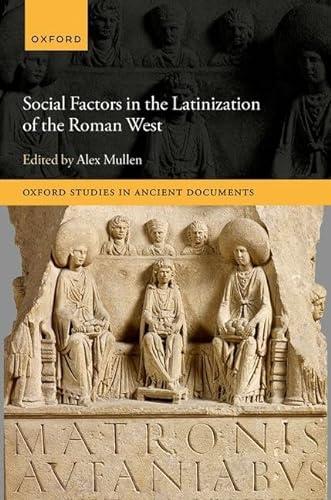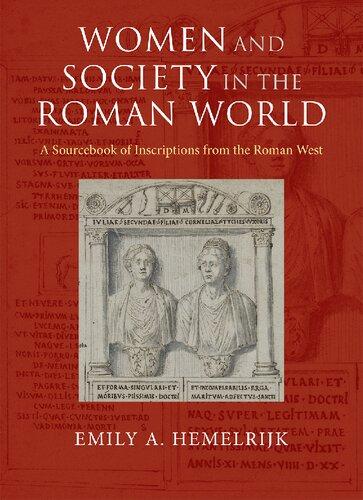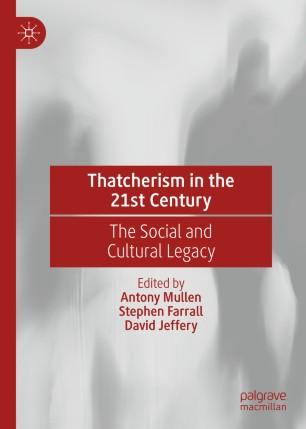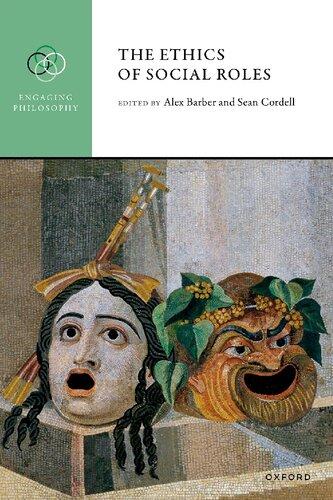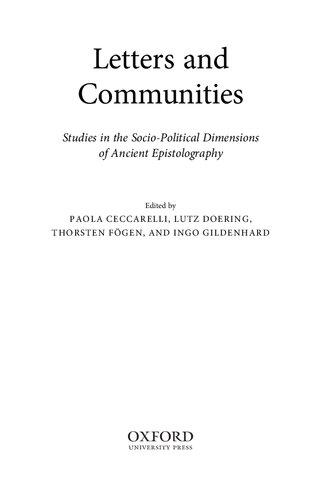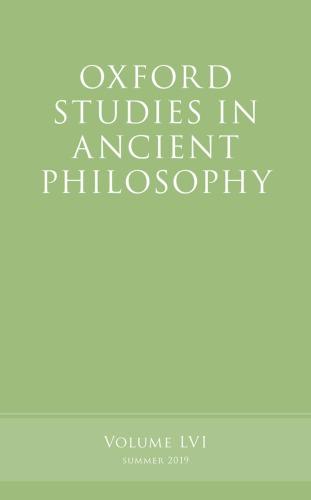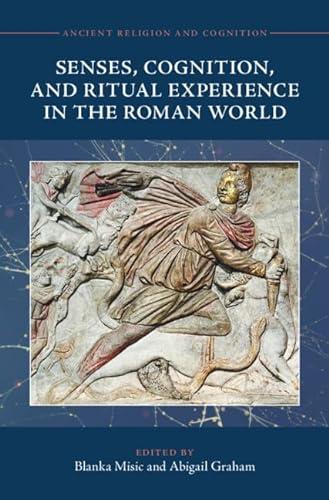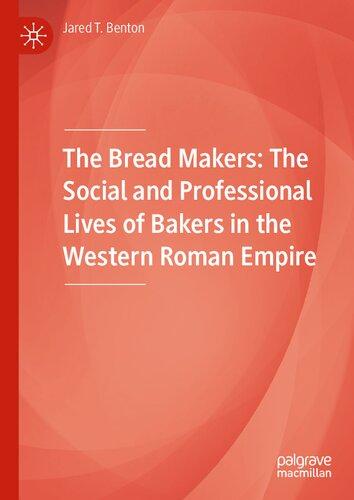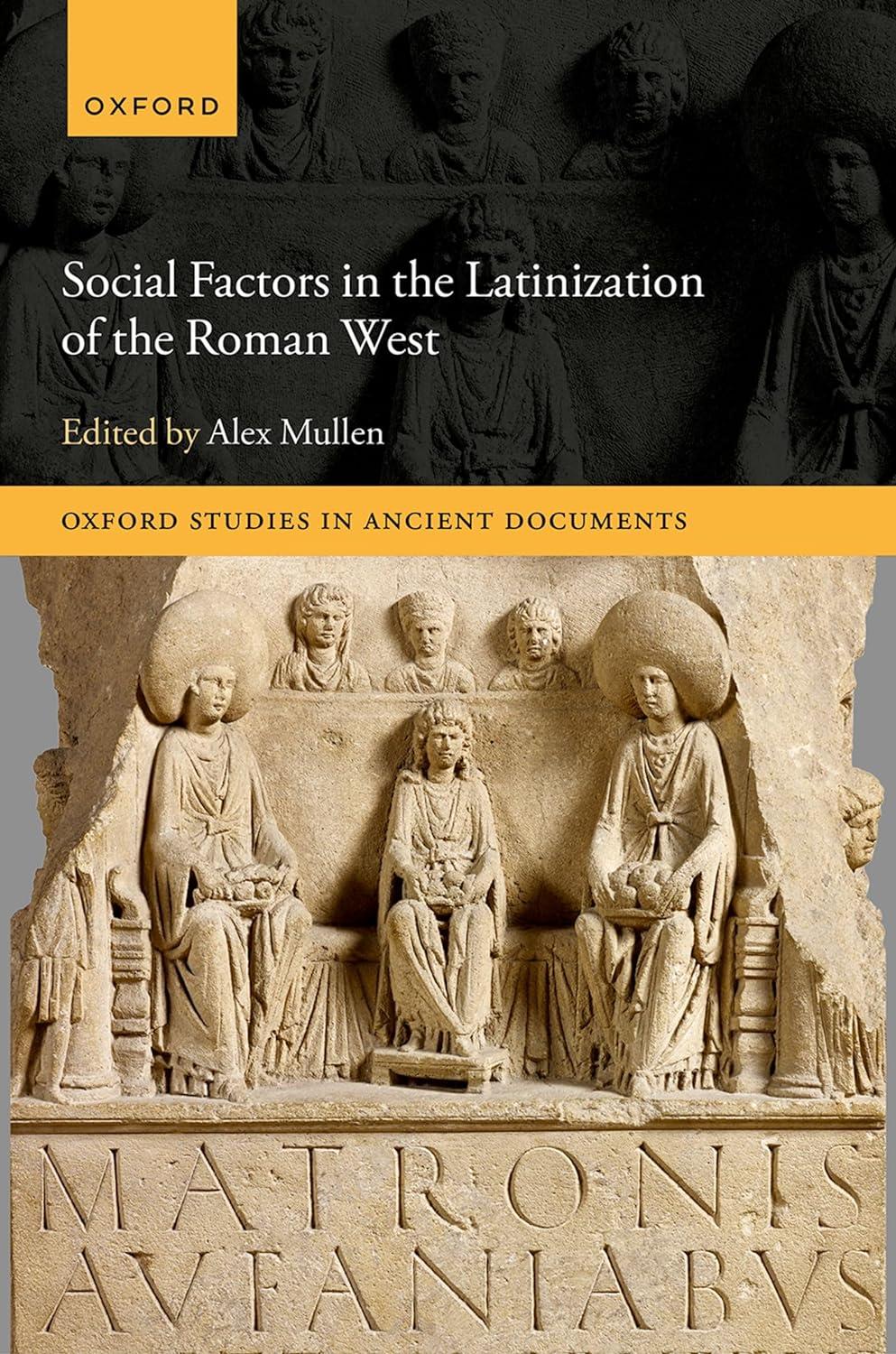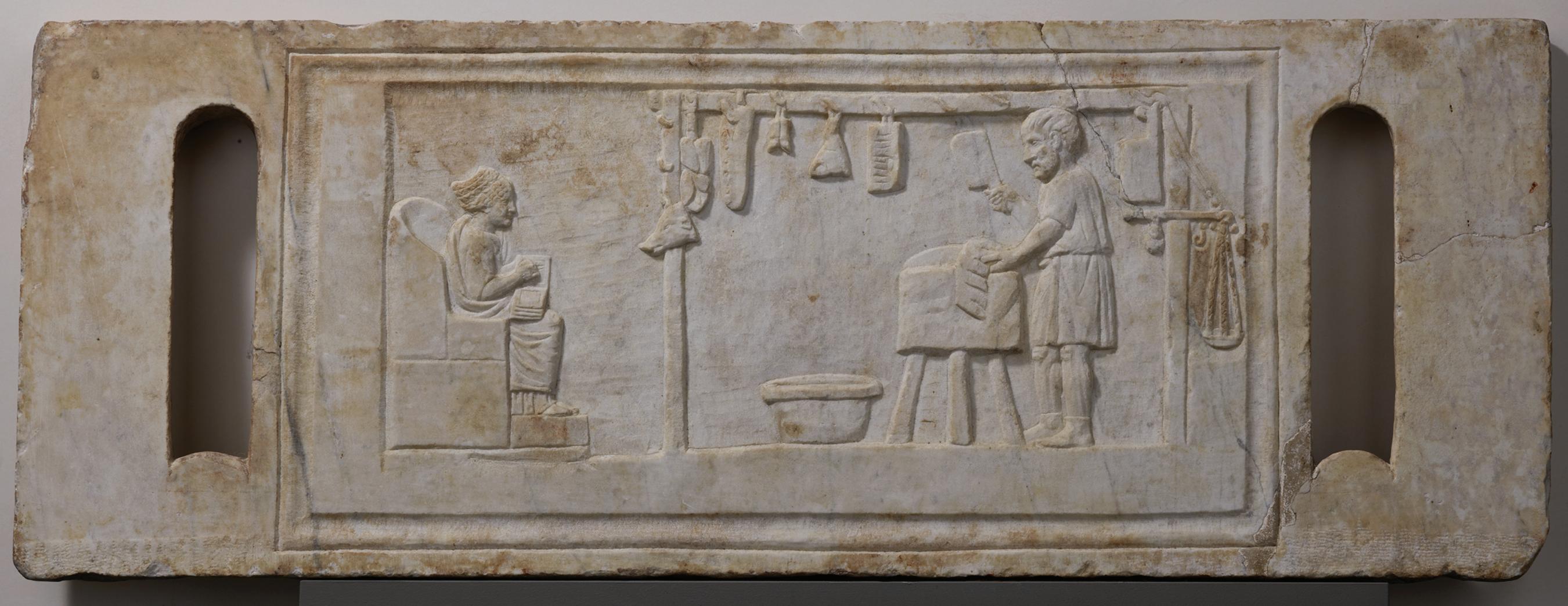1 Social Dimensions of Latinization
Alex Mullen
1 Divine Latinization
faciamque omnis uno ore Latinos (Vergil, Aeneid 12.837)
I shall make them all Latins speaking one language1
So declares Jupiter at the end of Rome’s epic, a poem read, heard, and copied in writing exercises across the provinces, from the Bay of Biscay to Syria, the highlands of Britain to the deserts of Africa. Jupiter was successful: significant linguistic reconfiguration happened under Rome,2 and in the western Mediterranean provinces this was well underway by the time Vergil composed these words. At the end of the Roman period, a patchwork of local languages had been replaced or joined by Latin in most of the West.3
Jupiter’s words raise issues that confront the sprawling subject of Latinization. From this line of verse, and Juno’s words that precede it, we might assume that for Augustan Romans language was an important element of communal identity, as it is and has been, to varying extents, for many communities. What is interesting here is that it is not the locals who are being forced to take on the language of the conquerors, but rather the Trojans, who in return for settlement in their Italian promised land have to submit to the local vernacular. Are they, in a sense, being presented as a model for the future inhabitants of the expanding Roman world,
This output has received funding from the European Research Council (ERC) under the European Union’s Horizon 2020 research and innovation programme under grant agreement No. 715626 (‘LatinNow’).
1 All translations are my own.
2 The significant epichoric inscriptional output of the Italian Peninsula had halted by the end of the social war; see Crawford (1996a). Commentators suspect that the languages themselves, excluding Greek, were also lost (perhaps except for very restricted use/antiquarian interest) by the end of the first century ce ; see Clackson (2015a), 78.
3 In this volume ‘West’ and ‘East’ refer to the two linguistic halves of the Roman world, the former composed of the western provinces stretching from Britain to the Balkans and including North Africa apart from Egypt and Cyrenaica, and the latter stretching from the Balkans to Syria and including Egypt and Cyrenaica. The linguistic boundary, based on the division between dominance of Latin or Greek usage, is sometimes referred to as the Jireček Line (Jireček 1911). The focus for all the chapters is Latinization: three consider primarily one region (Gaul, Britain, the Iberian Peninsula), others the western provinces or the Roman world more broadly.
Alex Mullen, Social Dimensions of Latinization In: Social Factors in the Latinization of the Roman West. Edited by: Alex Mullen, Oxford University Press. © Alex Mullen 2023. DOI: 10.1093/oso/9780198887294.003.0001
demonstrating that provincials need to take on Latin to constitute and create that new world? Would continental auxiliaries copying these verses in the barracks along Hadrian’s Wall or local elites in schools of rhetoric in Gaul have seen it this way, and, if so, how might they have responded? Reconstructing the attitudes and identities of the heterogenous provincial communities of the Roman West is no easy task, and the extent to which these may, or may not, have played a role in the linguistic developments under the Empire is even more uncertain. How do we recover the local voices of the inhabitants as they find themselves caught up in Rome’s expansion?
Elsewhere Vergil has Jupiter and other actors in the Aeneid encapsulate what might be interpreted as an empire-building and ‘civilizing’ mission for the Romans, a theme confronted in several of the contributions and revisited, again through Jupiter’s words in the final book of the Aeneid, in the afterword to this collection. Other ancient authors portray this mission specifically in the context of the expansion of the provinces and again highlight the linguistic aspect. Pliny the Elder, for example, claims that the gods have chosen Italy so that:
caelum ipsum clarius faceret, sparsa congregaret imperia ritusque molliret et tot populorum discordes ferasque linguas sermonis commercio contraheret ad conloquia et humanitatem homini daret breuiterque una cunctarum gentium in toto orbe patria fieret. (NH 3.39)
it might make the heavens themselves more glorious, unite the dispersed empires, civilize behaviour, draw together the discordant and wild tongues of so many peoples in a shared language, bestow humanitas on mankind, and, in short, become the one fatherland of all nations of the Earth.
These Romano-centric passages do not offer a subtle assignment of agency: a divine power, Jupiter for Vergil and numen deum for Pliny, makes these things happen to other peoples, the Trojans in one case and the provincials in the other. This raises the question, which has troubled commentators for some time, whether any imperial language policy was involved in the Latinization process, or whether it happened gradually and spontaneously, with provincial agency. As we shall demonstrate in Section 4, while the Empire may not, at least perhaps until Diocletian, have had a single, all-encompassing language policy, there was certainly an interest in what sociolinguists term language management, including the expression of language ideologies and agreed norms of practice.4
4 ‘Language policy’ refers to governmental-level decision-making and implementation of directives about language use. ‘Language management’ is a broader term, used to refer to ideologies, approved practices, and lower-level rules about language use. The line between the two, especially in the absence of evidence, can be hard to draw, hence the specifications ‘single’, ‘all-encompassing’, ‘widespread’ attached to language policy here.
If we agree then that no widespread language policy that set out to replace local languages with Latin existed in the western provinces, how should we understand the mechanisms involved in Latinization ‘on the ground’? It seems clear that a series of social factors made Latin appealing;5 however, when language is considered by ancient authors in a context that we might deem relevant to this process, including indeed in the two passages above, it is usually closely linked with humanitas,6 ‘religion’, ‘customs’, and ‘laws’. This raises an issue with which the contributors to this volume have all wrestled: since life is full of intertwined sociocultural elements, and language is part of everything and linked to everything, how can we successfully isolate and assess the impact of specific factors that may have promoted the spread of Latin?
2 Social Dimensions and Challenging Assumptions
The process of Latinization is central to understanding life and languages in the Roman West. But the substantial linguistic changes under Roman rule have often been treated as simply an unremarkable part of ‘Romanization’. As Woolf remarks, ‘Romanists sometimes take the existence of the Latin West for granted’.7 Even the term ‘Latinization’ is far from ideal. It risks attracting unwanted assumptions: that the focus is uniquely on Latin, that provincials jump onto a process with a desired and ‘civilized’ endgame of becoming ‘Latinized’, and that Latin itself is a monolith. This volume, and our work more broadly in the LatinNow project, instead explores diversity.8 We are interested in the provincial voices, from those who continue to speak and write local languages, to those who become bilingual and those who shift to Latin relatively quickly. We focus on the range of their divergent experiences,9 multiple identities, and variegated linguistic environments. Importantly, we appreciate that even those who take on Latin do not necessarily do so to take on a Roman identity, though several chapters eloquently explain why this is often the case, and explore the mechanisms behind it (Beltrán, Meyer).10
We should avoid thinking in simplistic terms whereby Latin = Roman identity, and non-Latin = local identity. Latin was often a practical means to an end—for example, in the internal administration of the pottery of La Graufesenque, where it appears to have been used interchangeably with Gaulish, sometimes producing mixed texts born out of the mechanical combination of linguistic material from
5 For key discussions, see Cooley (2002); Woolf (1998), esp. ch. 4.
6 See Woolf (1998), 54–60, for a discussion of humanitas 7 Woolf (2002), 181.
8 Mullen and Willi (forthcoming) presents the interdisciplinary labours of the team by Roman province; Mullen and Woudhuysen (forthcoming) the post-Roman continuation.
9 See Mattingly (2011) for ‘discrepant experience’. 10 See also Beltrán (2015a).
different oral and written sources that used alternately Latin or Gaulish. These first- to second-century ce firing lists and associated documents reflect a mass production centre that worked bilingually, with some individual potters apparently even having both Latin and Gaulish names, which could be used as appropriate. Through detailed analysis of the language in context, we can reconstruct the possible nature of oral and written bilingualism and start to hear these provincial voices in their workshops. In their firing lists we do not sense a concern with the presentation through language of binary Roman/local identities.11 For scenarios such as these commentators have argued that Latin seems to have played a part in the creation of a range of new realities in local communities that cannot necessarily be tied to ‘becoming Roman’ in a narrow sense.12 Indeed, provincial Latin itself is complex: there is no one Latin, as we often conceive of it through our grammar books, but rather an array of regional and social variations.13
To situate this complexity, the core chapters of the book (2–12) begin and end with wide perspectives: Beltrán reaches back into the pre-Roman world, squeezing information from the sometimes ineloquent epigraphic remains, and Rochette extends our view to the sixth century ce , deploying (and challenging) a range of guides from Suetonius to Pope Gregory the Great. These chapters highlight the disciplinary and evidential depth and breadth of this volume: contributors are imperial and late-antique Roman historians, Roman archaeologists, literary scholars, epigraphers, papyrologists, and sociolinguists—often in combination. They each focus on a factor in Latinization, but intersecting factors mean that the volume should ideally be read as a whole, and the limitations that the authors identify in assessing their drivers of Latinization should be heeded.14
The volume has been ordered by linking threads. With Beltrán (Chapter 2) we delve into the nature of epigraphic cultures across time and space. He explores the links between status, epigraphic habit, and Latinization, and the specificities of the ‘core’ and ‘peripheral’ regions of the Roman West compared to the East, which help to explain the linguistic developments. He ends with a focus on the Republican Iberian Peninsula, showing differences between the functions of local languages and Latin in written sources from Ulterior and Citerior, the result of the differences in the ‘linguistic configuration of both provinces’ (p. 47). Houten
11 There is a striking difference between the flexibility seen in the internal documents and the stamps on the samian ware sold across the Empire, which exclusively use Latin. Both Wilson and Wolff deploy this material in their chapters. It is important to remember that, though La Graufesenque is the best-attested example of its type, there is documentary evidence from other western provincial potteries. Recent discussion of language and literacy in the internal administration of mass production potteries can be found in Mullen (2023b; forthcoming b).
12 See Hingley (2005), 102. 13 Adams (2003a; 2007; 2013).
14 See, e.g., Houten, p. 52, Kolb, pp. 119–20, and Wiśniewski, p. 249: ‘[t]he frequent problem that sociolinguists have with distinguishing the impact of religion from other factors of linguistic change is particularly acute in this case, as Latin was the language of religion, culture, and power.’
(Chapter 3) explores the same peninsula, deploying modern sociolinguistic models to illuminate the role that the development of urban centres may have had in the spread of Latin and epigraphic culture, and setting it in the longue durée. His chapter intertwines the theme of status, already linked to colonization and municipalization by Beltrán, with that of trade, showcased by Wilson in the next. Status is indeed vital to understanding Latinization and a thread that runs through all the chapters. It is worth restating that status can be situational and multiple, a perspective echoed by Horster in her closing discussion when she argues the importance of exploring the ‘multiple roles’ of individuals. An auxiliary solider, for example, might have a high status in a specific local context thanks perhaps to physical prowess and ties to a family with deep-rooted local status, and the status symbols of the army and the eventual receipt of Roman citizenship may confer further power and influence depending on the community’s relationship with Rome. But that same solider, according to his rank, may have a low status within the army itself and, though a Roman citizen after discharge, outside his local community might, in some contexts, reside towards the bottom of the citizenship hierarchy. Provincial elites with an apparently lesser category of citizenship, the Latin right rather than Roman, might well have considerably higher status, dependent on their backgrounds and routes to Latin citizenship, than those who receive full citizenship as veterans.15 In fact ‘it would be dangerous to assume that families with Roman citizenship were wealthier or better connected than their non-citizen peers, merely because they had Roman citizenship’.16
Wilson’s Chapter 4 draws on decades of research on the Roman economy to argue that it must have been a key driver of Latinization, focusing on the Latinizing effects of slavery, traders, and mobile craftsmen, and arguing that learning Latin would have reduced transaction costs in the same way as a single currency. Taking up the story in early Britannia, Cooley (Chapter 5) presents an alternative model to Latinization via the military or local elite, through a case study of early Londinium. She searches out the mechanisms, including economic activity, that might explain differential Latinization and the social groups that might have acted as vectors. Kolb opens Chapter 6 with more of these potential vectors: the traders with Britain making dedications at Colijnsplaat, now in the Netherlands. She explores the physical vectors of spread, driving home the impact of Roman transport infrastructure and the physical messages along its routes that both reflected and created linguistic context. She suggests that, even in public and highly symbolic Roman milestone texts, there is evidence for a pragmatic tolerance of local linguistic environments, an attitude that she, with others in the
15 It is worth remembering also that Roman citizenship, while generally thought of as a desirable and privileged status, also brought with it certain constraints—for example, concerning marriage and inheritance; see Ando and Lavan (2021), 20–1.
16 Ando and Lavan (2021), 13.
volume, argues may have contributed to the success of Latin in the West.17 Speidel in Chapter 7 investigates the army, a group that in some cases built, and in many cases exploited, this infrastructure. He forces us to rethink one of our most closely held assumptions about Latinization, and his argument will be considered further in Section 5. Wolff (Chapter 8) takes up more expansively the theme of education in the West, which Speidel has considered for the army. She provides a welcome survey of evidence from the provinces, beginning with the well-known, but arguably weakly helpful, literary sources, before turning to epigraphy and archaeology. Finding little evidence for formal structures of education and echoing the thoughts of many other contributors, she concludes that learning in the provinces was commonly undertaken in an informal and ad hoc fashion.
Meyer’s rich contribution (Chapter 9) aims to illuminate the links we commonly make between Latinization and the law, demonstrating how embedded they are in particular with status. Looking to the early legal texts displayed in the Iberian Peninsula, and echoing Houten’s chapter, she argues that in those communities even Latin speakers would have struggled to understand the complicated legal concepts, but that instead ‘they were accepting, and assimilating, a prestigious Roman cultural package’ (p. 187). She then moves into the realms of the non-elite, taking us into sometimes disconcertingly unfamiliar territory produced by the overlap between justice, religion, and magic, and finding therein drivers for Latinization. Cazanove and Estarán explore this territory further in Gaul for Chapter 10, weaving together archaeological and sociolinguistic perspectives. They highlight the multifarious nature of religious and magical practices, demonstrating that Latinization and Roman epigraphic culture are spread by some practices, notably in the imperial cult, but that local languages and their epigraphic expression are retained by others. Careful contextual analysis allows the authors to discuss different rhythms of Latinization across some regions of Gaul and to question our assumed dating for linguistic and epigraphic change. Wiśniewski, in a provocative chapter (11) that might challenge received wisdom, argues that Christianity did not have a major Latinizing effect on the western provinces, since they were essentially already Latinized (see further below). Rochette (Chapter 12) then takes us from Augustus to Justinian focusing on those at the very top of the Roman power pyramid, trying to recover their attitudes towards language politics and the ways in which these might, or might not, have had any impact on their empires.
The factors that are explored—status (including citizenship), urbanism, administration, the economy, infrastructure, mobility, the army, education, law, imperial religion, Christianity, language management, and attitudes—are widely seen as drivers of the spread of Latin, and indeed can be reflected in studies of the
17 See Chapter 13 for a different reading of the motivation behind the use of the local language in this context.
spread of languages in other cultures.18 The contributions together, however, offer something new: they confront the complexity from a multidisciplinary perspective, offer more sensitivity to the provincial perspective and local languages, and, in some cases, challenge our assumptions. The army and Christianity are not major factors, at least according to Speidel and Wiśniewski, slavery appears as an overlooked driver (Wilson), and Meyer takes us from the familiar territory of elites needing Latin to access legal privilege and protections to a more radical exploration of the pursuit of Latin for Volksjustiz by the sub-elite. Differential Latinization can be witnessed across the provinces, and the way that both the pan-provincial social factors and local specificities might interplay in generating this complexity is vital to understanding the macro-sociolinguistic and broader sociocultural picture. Indeed, together they are crucial in constructing a social history of the Roman West.
The contributors warn us, and particularly Horster in her closing remarks, not only about assumptions but also about the fragile evidential basis. On the question of the linguistic role of Christianity in the West, Wiśniewski argues that, ‘while the impact of Latinization on Christianization is obvious, the opposite relation is less so’ (p. 256). He argues that any linguistic impact by Christianity would have been experienced far from cities in more isolated regions, which may not have been Latin speaking even in the fourth century, when Christianity was starting to penetrate the rural interior. But, while Wiśniewski can find evidence for Christianity’s enhancement of literacy among the provincial clergy, he bemoans the fact that he cannot reach into rural contexts and see how local people may have communicated with this group. Key settings can often be approached only through indirect comments from other contexts and fortuitous scraps of evidence.
The familiar spectre of the relationship between spoken and written language haunts all the chapters and creates troubling dark patches that the contributors valiantly combat. Even when we have Latin texts, we cannot be sure whether their ‘authors’ spoke Latin: reliance on manuals, basic rote learning, and support from go-to literates make even this most straightforward of assumptions shaky. The recent optimism of a palaeographer that the Roman world exhibited a ‘very high level of literacy and [. .] intense and diffuse graphic practices in every corner of the empire, as the documentary finds themselves bear witness’19 cannot easily be supported. While literacy was successful ‘horizontally’ across contexts and functions, even reaching rural contexts in so-called peripheral provinces such as Britannia (Cooley) and into local administration of potteries (Wilson), it never attained the same ‘vertical’ depth. The Roman world was highly literate, ‘bound together by writing [. . .] both a social symbol and an integrative by-product of
18 For some thoughts on comparative sociolinguistic studies, and the common links made between the spread of English and Latin, see Mullen (forthcoming a).
19 De Robertis (2020), 41–2. For a similar view, see Öllerer (1996).
Roman government, economy, and culture’,20 but literacy remained low, in any case nowhere near the levels reached in the industrial period onwards.21
One casualty of this wide, but not deep, literacy is that various groups can end up neglected. In this volume half of the Roman world’s population appears only occasionally. This is in no small part because women are less (obviously) engaged in our written sources, which are dominated by male actors, whether soldiers, elites, or craftsmen. Women do appear, particularly in lapidary inscriptions,22 but commentators are (rightly) cautious about who writes and produces these inscriptions, and (arguably wrongly) often make an assumption that males are the creators. One might suspect that women were more engaged with our non-lapidary sources than their relative lack of named appearances within them suggests,23 with famous exceptions, such as the birthday invitation from Vindolanda (Fig. 1.1). We catch glimpses of these possibilities in iconography, such as the image of
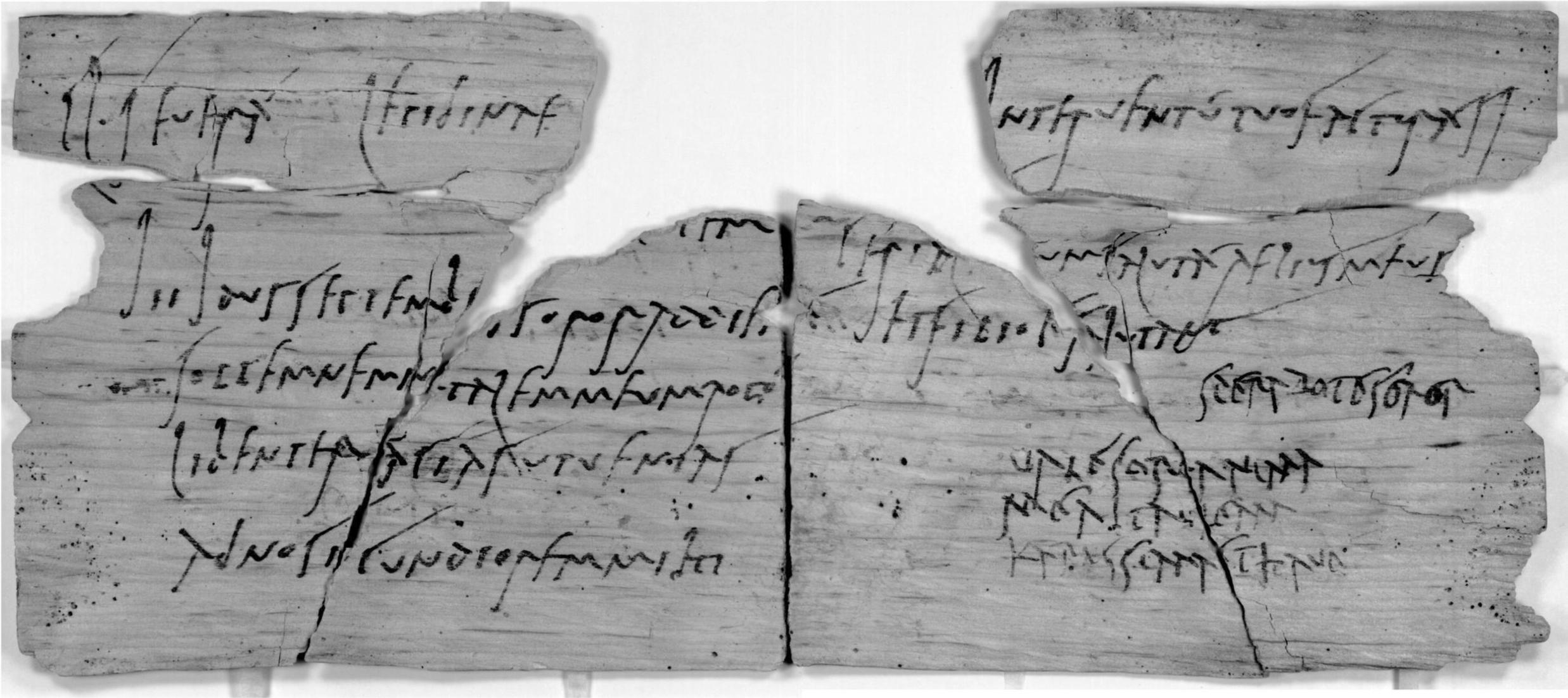
Figure 1.1 Ink-written wooden-leaf tablet with birthday invitation from Claudia Severa to Lepidina, 97–103 ce , found at the Vindolanda fort. The final four lines on the right-hand side are a personal message, probably added to the message by Claudia Severa herself. (British Museum, CC BY-NC-SA 4.0.)
20 Hopkins (1991), 144.
21 Levels of ancient literacy have been discussed intensively over the decades, with a fixation on Harris (1989). In order to advance understanding of literacy in the Roman world, we should integrate a broad evidence base, not only the variety of non-lapidary epigraphy (writing tablets, curse tablets, so-called instrumentum domesticum, etc.)—which has increasingly been on the agenda in recent decades, including for Harris (e.g. 1993; 1995; 2014)—but also the non-textual sources, particularly the archaeological evidence for writing equipment. For a more fruitful approach, termed socio-literacy, see Mullen (2021). This subject is treated in detail in Mullen and Willi (forthcoming). For an introductory guide to Roman writing equipment, see Willi (2021); for the archaeology of writing, see Eckardt (2018).
22 See Hemelrijk (2021).
23 Note, for example, the complete absence of women in the texts of the Bloomberg tablets (Tomlin 2016), 57. Conversely, women seem to be more widely attested in the graffiti from Pompeii; see Milnor (2014), ch. 4; Woeckner (2002); they also appear relatively regularly in the so-called curse tablets in the north-western provinces, in which McKie (2017) finds 24% of the victims and 22% of the petitioners are female.
the butcher’s ‘wife’ from a relief found in Rome (Fig. 1.2), the Campanian wall paintings,24 and the numerous burials of women across the provinces containing writing equipment.25 As commentators of the ancient world, we have to strive to make sense of this dispersed evidence, and perhaps the frequent depositing of writing equipment in female funerary contexts should at least encourage those who assign agency in literacy to men to pause. We can imagine that women might have found Latin literacy useful for undertaking record-keeping for their male relatives, taking up the (admittedly certainly not gender equal) opportunities offered by the Roman world,26 cementing their status and extending access to the same for their children.
Sociolinguistic models from the modern world help us relatively little on this issue: women act as conservators of traditional language in some communities and are at the forefront of linguistic change in others,27 and the contexts are so
Figure 1.2 Funerary relief, dating to 140–150 ce , found reused in a building in Trastevere. It shows a butcher at work, with a female presumably engaged in bookkeeping. (© Skulpturensammlung, Staatliche Kunstsammlungen Dresden, inv. Hm 418. Photograph by H.-P. Klut/E. Estel, reproduced with kind permission.)
24 Writing equipment and acts of writing on tombstones are almost exclusively associated with men. The women with writing equipment on the wall paintings have had their literacy denied by Meyer, who argues that these women have the ‘pose and attributes of Muses’, and ‘if they [the artists] attempt to depict “real” women, they at best convey female aspirations to unreal qualities. Men could aspire to the literary life, but their companions—Muses or women portrayed as Muses—could only aspire to inspire it’ (Meyer 2009, 589).
25 For focus on writing equipment in graves, which shows that women’s graves are proportionally much better represented than we might have expected from the literary and iconographic evidence, see Eckardt (2017); (2018), 155–65; Lüginbuhl (2017). See LatinNow’s webGIS, gis.latinnow.eu, for Lüginbuhl’s data set. See Cooley, this volume, pp. 111–12, for a female burial from Southwark, London, which may contain unusual evidence for literacy.
26 For women in the civic life of the western provinces, see Hemelrijk and Woolf (2013). It is unclear to what extent women’s patterns of activity in the much richer documentary sources from Roman Egypt (Bagnall and Cribiore 2008) might be a model for the West. As our evidence from the West becomes more substantial, detailed comparative analysis should become possible.
27 See Clackson (2012), 52–7; Eckert and McConnell-Ginet (2003); Langslow (2002), esp. 28; Piller and Pavlenko (2004).
diverse and specific as to resist generalization. Similarly, we find examples of women as both linguistic traditionalists and innovators in the Roman world. Clackson (2012) raises the possibility of women having roles in vernacular persistence by drawing attention to the possible link between women and traditional linguistic and cultic activity (e.g. in Roman Gaul and the Veneto).28 But he admits that the evidence is ‘scattered’, and ‘hard and fast claims’ are elusive.29 A recent chapter in a book exploring ethnic diversity and cultural identity in the Roman world mentions a set of material relevant for this debate. Shaw notes that, in the funerary epigraphy from the mountainous Cheffia region of North Africa, all females bore names that look ‘very Latin’, and they are all memorialized in Latin: ‘Not one of them is memorialized in the palaeo-Tamazight script or in a palaeoTamazight/Latin bilingual.’30 This is in contrast to the men of the region, who were identified with ‘elements of traditional culture and ethnic affiliation’.31 Shaw opines that
there must surely be a strong presumption that indigenous women, as in many comparable instances in the western provinces of the empire, were special bearers of local identity [. . .] Apparently these women, who were surely in the majority, simply did not present themselves in the field of public epigraphy.32
Whether in the minority or not, it seems as if in Cheffia there may have been women who were linguistic innovators, or at least they were publicly associated with such behaviours. As Clackson suggests, we should be alert ‘to gender as one of the potentially important factors in language conservation and language shift’,33 and not shy away from stitching together the clues.
3 Voices of the Provinces
Classicists have rarely engaged fully with the non-classical languages that the western provincials they study spoke and, in some regions, wrote. ‘Voices of the provinces’ tend to be those found in provincial Latin epigraphy. Books devoted to ‘the local’ frequently ignore texts written in local languages.34 Most of the chapters in this volume, however, integrate the full range of written materials, from the
28 For Gaulish, see Mullen and Ruiz Darasse (2020). For the Venetic material from the sanctuary of Este-Baratella, see McDonald (2019).
29 Clackson (2012), 56, 57. 30 Shaw (2021), 74.
31 Speidel uses this same evidence for military men not using Latin in their home communities (p. 138).
32 Shaw (2021), 74. 33 Clackson (2012), 57.
34 For an example, see Johnston (2017). Omrani’s evocative travels (2017) in Roman Gaul do not consider Gaulish materials.
Phoenicio-Punic and Palaeohispanic in the Iberian Peninsula (Beltrán and Houten) to Gaulish (Cazanove and Estarán).
In ranging over this material, all the contributors grapple to a greater or lesser extent with the relationships between language and identity. Beltrán reminds us that the links between languages and identities are socially constructed and vary greatly over space and time, warning against extrapolating the ‘very particular function in the modern Europe of nations’ (p. 35) to other contexts. He cites Crystal’s declaration that ‘language is the primary index, or symbol, or register of identity’,35 arguing that it falls into this trap. But the point of Crystal’s statement is perhaps rather that languages are always related to some form or another of identity/ identities, which is different from saying that languages are always specifically linked to national identity.36 Modern sociolinguists and the contributors are therefore in accord. The issue that arises is then which of the various multiple identities that any individual/community/region might hold, and which of the different aspects of their environments and interactions, can be linked to aspects of language use and attitudes. This goes to the heart of what sociolinguists of the ancient world want to do, the struggles that they face, and why they are potentially fundamental in constructing Roman histories.
Sociolinguists of provincial communities do not receive much help from Roman commentators. Elite Romans, particularly perhaps those not of provincial origins,37 were generally not interested in writing about the myriad languages other than ‘their own’ Latin and Greek,38 nor in carving up linguistic realities into mono-, bi- and multilingualism,39 despite the fact that bi- and multilingualism was commonplace.40 Highly educated Romans, mirroring Greek practice, focused
35 Crystal (2000), 40.
36 Indeed, in the pages preceding this quotation, Crystal is talking about regional dialects of English in England.
37 The ‘local’ western provincial elites had, particularly in non-Mediterranean provinces, close links to non-Latin-speaking communities and may have even continued to speak local languages. But their voices are not commonly heard in the extant literature, and, when they are, the medium, as a result of social pressures, is Latin.
38 Bozia and Mullen (2021); Lejeune (1949); Rochette (1995).
39 Concepts akin to modern ‘bilingualism’ and ‘multilingualism’ do not seem to have been much in evidence (see Dubuisson 1983 for vocabulary of Roman bilingualism), and modern linguistic ways of thinking about, and describing, bilingualism are not obviously in view. Romans used the term utraque lingua, literally ‘both languages’, which is often translated as ‘both our languages [Latin and Greek]’. But the main use of utraque lingua has ‘une forte résonance culturelle et littéraire’ (Dubuisson 1981, 281), rather than purely linguistic. It seems that this term was preferentially used by Roman elites to encode entanglement of Greek and Latin culture (though not exclusively; for the occasional use of utraque lingua/uterque sermo beyond Latin–Greek, see Biville 2018, 22). bilinguis, used in Roman texts merely a handful of times and often reserved to describe ambiguous, misleading speech rather than bilingualism as we understand it, was usually reserved for ‘foreigners’ (Carthaginians, for example); see Elder (2019); Poccetti (1986).
40 For bi- and multilingualism in the Roman world, see Adams (2003a; 2003b; 2007); Adams, Janse, and Swain (2002); Biville (2018); Biville, Decourt, and Rougement (2008); Clackson (2015a); Clackson and Horrocks (2007); Cotton et al. (2009); Ruiz Darasse and Luján (2011); Kaimio (1979); Millar (1968); Mullen and James (2012); Mullen (2013a); Rochette (1997; 2010a).
primarily on the standardization of Latin, notions of purity and excellence in language,41 and in the relationship in utraque lingua. Those in the higher echelons clearly knew about aliena lingua and alienus/externus/peregrinus sermo. They referenced foreign languages in ethnographic discussions,42 exhibited curiosity when it came to loanwords, and must have grappled with them through interpreters,43 but compared to their obsession with Greek these multiple languages received little attention,44 perhaps with the exception of Etruscan and Punic.45 Ovid bemoans being exiled among ‘barbarian’ communities on the Black Sea, and eventually claims to have learnt Getan and Sarmatian (Tristia 5.12.58), but we learn precious little about these languages.
When we turn to the provincial populations, it is arguably nigh-on impossible to reconstruct linguistic ideologies and attitudes for the masses, who did not leave behind any writing, let alone descriptions of their relationship with languages, identities, and cultures.46 Beltrán is even relatively pessimistic about the prospects of recovering the relationships with Latin that the creators of the epichoric inscriptions may have experienced:47 ‘we do not have any account from a local perspective of the reasons why Latin displaced local languages so radically, despite not having been imposed by Rome’ (p. 49). But, thanks to pioneering work led by Beltrán in the documentation and analysis of the Palaeoeuropean
41 Clackson (2015b).
42 See the statements at the opening of Caesar’s Gallic Wars, where the communities of Gaul are (crudely) divided according to lingua, instituta, and leges (language, customs, and laws).
43 See Mairs (2023; 2020); Wiotte-Franz (2001); Wilson, this volume.
44 Rochette (1995), 12, claims that Latin grammarians before the Byzantine period, with the exception of some etymological comments in Varro, do not make reference to ‘local’ languages. This overlooks the work of, for example, fourth-century Consentius (De barbarismis et metaplasmis) which discusses the barbarism of provincial speech (the focus on regional varieties of Latin) and barbarolexis (words in Latin from foreign languages) (Mari 2021). Admittedly, however, Consentius’ focus is overwhelmingly on the former. Biville (2018) is right to temper the notion, inspired, in her view, by Lejeune (1949), that Romans are never interested in local languages, but her snippets of largely nonspecific evidence scattered over centuries (e.g. uox diuersa used to describe the hubbub of large audiences/communities) hardly support her conclusion that ‘[w]e owe thanks to Romans for this advancement in the history of the plurality of languages’ (Biville 2018, 24). Indeed, earlier in her chapter she states that, ‘[a]s languages that were “other” in their relationship to Latin, and diverse in their plurality, foreign languages also were generally relegated to the generic category of barbaric languages. They did not even deserve to be taken into account and differentiated because, unlike Latin and Greek, they were languages neither of international power nor of international learning, and above all, because very few people could understand them’ (Biville 2018, 12).
45 Claudius apparently wrote histories of the Etruscans and of the Carthaginians, which might have required some knowledge of the languages (Cornell 1976). Mago’s treatise on agriculture was translated from Punic and several lines of Punic appear in Plautus’ Poenulus. See Roller (2022) for early Punic geographical writings.
46 But crude commentary about the spread of Latin can be made using the distribution of writing equipment in provinces where only Latin is written; see Mullen (forthcoming c).
47 Clackson (2015a), 13, remarks that ‘[m]ost speakers and writers in ancient Greek and Latin did not have the vocabulary to make a distinction between classing something as a language or a dialect’. ‘Epichoric’ is used in this volume to designate ‘local’, while also explicitly excluding ‘colonial’ local— i.e. Latin can be a local language but not an ‘epichoric’ one.
languages,48 we have been able to explore linguistic practices and attitudes using apparently unpromising materials.49 We can use sociolinguistic techniques supplemented by detailed contextual information to explore the sociolinguistic dimension of life in the provinces. Instead of focusing on what the text directly imparts, we listen to the ‘micro-sociolinguistic’ features, the monophthongized diphthongs, the weakened consonants, the loanwords, the interference from second languages, the simplifications of case usage, and map their occurrence against a range of social factors. We can consider the ‘macro-sociolinguistic’ picture too: choices of language for different functions, for example, or speed of death of certain variants or extent of bilingualism. These two levels of sociolinguistic analysis have been a major focus since the turn of the millennium, inspired in particular by the work of Jim Adams and József Herman, and continue in projects such as the one that produced this volume.
The western provincials participating in the vast Roman documentary output would have had a sense of what standard forms of Latin were, compared to any other local languages they would have spoken. Formal Roman military, administrative, and legal texts, for example, followed strict and widely adopted conventions about layout, linguistic and orthographic norms, formulae, and script.50 From first-century ce London, in the early days of the province, the so-called Bloomberg stylus tablets, containing largely financial and legal documents presumably written by a mix of continentals and Britons, demonstrate the early and wholesale adoption of Roman documentary practices (Cooley).51 It is hard to see how people engaged in these formal documentary contexts could not have had a sense of linguistic norms.
Conversely, the vast majority of provincials not directly involved in the Roman imperial documentary machinery were probably used to operating in a context of more flexible multilingualism, where often related Indo-European local languages (Celtic and Germanic varieties in some of the northern provinces) and types of Latin (regional vernaculars such as British Latin and Gallic Latin) would have been picked up and used as necessary.52 These western provincials, the majority of whom continued to live in rural settlements, did not have access to systematic education, and educational materials for learning local ‘indigenous’ languages, as far as we can tell, did not exist.53 In the absence of a nation-state-style linguistic
48 See, most recently, the series of chapters on Palaeoeuropean languages: https://ifc.dpz.es/ojs/ index.php/palaeohispanica/issue/view/20. Palaeoeuropean languages are the attested non-colonial languages of Europe, the earliest written stratum of local languages. This is a modern usage defined by Beltrán and team and should be distinguished from Alteuropäisch, which refers to a reconstructed prehistoric linguistic strata of Europe before the advent of writing.
49 See Mullen and Willi (forthcoming). 50 For a flavour, see Mullen and Bowman (2021).
51 Tomlin (2016). The proportion of locals in the mix is unknown and may be low.
52 For regional varieties of Latin, see Adams (2007).
53 The known colloquia, grammars, lexica, and other language-learning aids are designed to teach Latin and/or Greek; see Dickey (2012). When we find evidence for rudimentary learning of the
ideology and of widespread formal language learning, languages may not have had circumscribed meaning for these provincials. Linguistic resources may have been carved up differently, and attitudes to languages and identities may have been based on now largely irrecoverable local concerns (slightly different forms of Celtic used in neighbouring villages or territories may have had significance, for example).54 In this context we might wonder whether provincials, with what we would consider more than one language, might have seen themselves as having multiple languages or a single repertoire, and whether they ever thought of themselves as bi-/multilingual. Speech was perhaps less constrained by socially and politically constructed ‘Languages’. In areas with intensive bi- and multilingualism, but little recognition of the conceptual hard lines linguists draw around linguistic resources to create linguistic entities, translingualism may have been prevalent. This concept can be used to refer to the complexities of oral and/or written outputs, which reflect flexible linguistic repertoires (involving, for example, hybrid forms or forms that we might classify as expressing more than one language at the same time, as we see in some of the texts on Roman-period spindle whorls).55 It is significant that we find hints of translingualism in written sources, since by their nature they tend to rely on more standardized linguistic entities. Through this enigmatic evidence we can try to evoke aspects of the range of mindsets and contexts, however difficult that might be, of the ancient producers and consumers of language.
One of the original and promising macro-sociolinguistic conversations that can be drawn from this volume evokes the possible existence of a local lingua franca in the pre-Roman and Roman context. Beltrán raises this in his consideration of why the Roman West behaves differently linguistically in comparison to the eastern Mediterranean. He argues that ‘powerful lingua francas’ such as Greek and Aramaic, supported by their cultural and literary traditions, partially explain the weak Latinization of the East, and that the lack of similar vehicular languages in the West helps to explain strong Latinization (p. 33). As with many of these social factors, it is hard to demonstrate a causal link, though the argument is enticing. Later, however, Beltrán makes a tentative case for the possible role of Gaulish, the Celtic language of Gaul, as a lingua franca of at least Celtic-speaking
alphabet, it is often difficult to be sure which is the language of instruction and/or writing. A tile from Châteaubleau (France) contains an alphabet from A to X, and then the start of a second, A to D, in less neat handwriting (the alphabet may have continued in the section of the tile that has broken off) (RIG II.2 fig. 131 bis). A dozen or so Latin inscriptions on tile have been found at the site, as well as a small number of Gaulish examples, so it is unclear whether this was intended to be an alphabet used to learn to write Latin or Gaulish in Latin script (‘Gallo-Latin’). For writing in tile production, see Charlier (2004). See also Wolff, this volume.
54 Work is underway in the RIIG project (https://riig.huma-num.fr/) to explore regional variation in the Gaulish epigraphic corpus, but the prospects are sadly limited given the available contextual evidence. Beltrán makes the essential point that, ‘where there is less epigraphic density and fewer literary sources, it is more difficult to establish linguistic or dialectal differences’ (p. 30).
55 For the spindle whorls and translingualism, see Mullen (2022).
parts of the western provinces. Though Kolb dismisses this possibility, her description of the use of the Celtic term for distance, leuga, in the Latin milestones from a swathe of the north-western provinces (pp. 128–32) might support the case. Gaulish is one of the few local languages written well into the imperial period, and it probably survives orally until at least the fifth century ce in certain rural, more isolated, and/or perhaps more ‘resistant’ environments.56 Before and during the early phases of Rome’s expansion, Celtic languages were spoken throughout Britain and Gaul, and in parts of the Germanies, northern Italy, and the Iberian Peninsula. In this context it might have made sense for local communities to deploy a form of Celtic as a linking oral language. To return to Beltrán’s argument, if we hold that having a ‘powerful’ lingua franca means Latin might embed less quickly, this could help to explain the slower Latinization in areas where the lingua franca, or a language close to it, was the widespread mother tongue of local communities—for example, in Britannia and parts of the Tres Galliae. Under this argument, though, we might worry about how to account for the apparently speedy replacement of Etruscan and Iberian, both of which seem to have performed linking functions and had cultural prestige. Perhaps a decisive factor may be the lack of a long-standing written tradition in those areas that exhibit possible traces of a lingua franca and apparently slower Latinization. The existence, and possible role in Latinization, of one (or more) western ‘local’ lingua francas and the correlation of slow Latinization with an absent epigraphic record are worth continuing to explore.
4 Policy Distraction
In providing a vision of the nature of Latinization in the western provinces, we need to see the picture from different angles. Scholarly discussions on the existence of language policy have focused on the practices of the ‘traditional’ elites and the administration of the Empire,57 deeming the sociolinguistic attitudes of the masses to be unimportant and/or impossible to reconstruct in the absence of explicit commentary. The reconstruction in Section 3 of lack of interest in local languages among elites and of flexible ‘translingual’ perspectives on linguistic resources for at least some lower-status groups may demonstrate why language policies may not have made much sense in the Roman world as a whole.
Nonetheless, perhaps influenced by modern notions of nation-state ideologies and their policies, scholars have searched for the evidence of a linguistic policy mandating the use of Latin in the West. The consensus is that there was none, at
56 For the survival of Gaulish, see Meissner (2009); Blom (forthcoming).
57 Dubuisson (1982).
